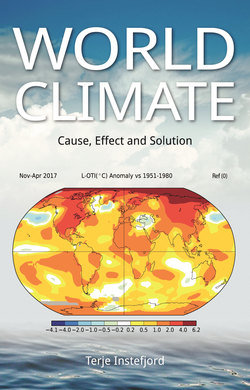Читать книгу World Climate - Terje Instefjord - Страница 5
На сайте Литреса книга снята с продажи.
3.2 The Ice Ages
ОглавлениеThe second reference point used is the Ice Ages.
From the Antarctica ice sheet, ice samples have been collected that show the climate over the last 800,000 years. These samples show that during this period there have been a number of relatively equally cold ice ages, separated by periods of warmer climate, with each ice age / warmer climate cycle lasting about 100,000 years.
The samples show that during the coldest periods of each ice age the CO2 content in the atmosphere was around 200 ppm, the average temperature was approx. 6˚C lower than now, and the sea level was approx. 120 meter lower. In the warmer periods between the ice ages the CO2 content in the atmosphere rose to approx. 300 ppm. (Ref 3 & 4).
What caused the ice ages is still uncertain. One theory supported by many scientists today is based on variations in the Earth's orbit around the sun. Three different cycles have been identified, with periods of 20, 40 and 100,000 years. (Ref 5). During these cycles the distance from the sun and / or the angle of the Earth's axis of rotation varies relative to average values. The 100,000 year cycle equals the time span between the different ice ages.
When the distance to the sun varies, so does the intensity of the received solar radiation. However, the variation in received solar radiation during the three orbit cycles is far too small to directly explain the significant climatic variations found during an ice age cycle.
This apparent mismatch between cause and effect can be explained by positive feedback. Due to local positive feedback even small changes in solar radiation can have major consequences on our climate.
More ice gives more reflection of incoming solar radiation, and thus lower temperature, which in turn gives even more ice and even more reflection
Less ice gives less reflection of incoming solar radiation, and thus higher temperatures, which in turn gives less ice and even less reflection.
In addition to this, variations in the angle of the Earth’s axis of rotation will affect the sun’s height above the horizon. The higher the sun is on the sky in summer, (winter in Antarctica) the more heating and melting.
